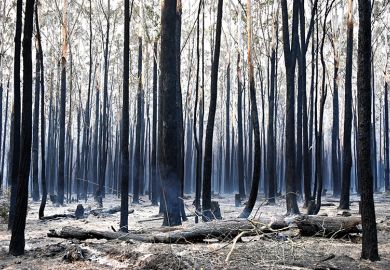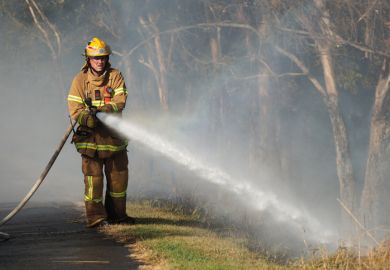As Australian universities brace for the bushfire season ahead, campus operations bosses are applying lessons learnt from the Black Summer of 2019-20.
Four years ago, universities were wrenched from holiday downtime by a firestorm unprecedented even by Australia’s harrowing standards. It scorched an area the size of the UK, incinerated a billion-plus native animals, destroyed around 3,000 homes and killed almost 480 people through fire impact or smoke inhalation.
This summer’s fires might not prove as devastating. The intervening period has ushered in three drenching La Niña climate cycles. Lingering moisture could impede the spread of fire, unlike 2019 when sustained drought had left the country bone dry.
But eastern Australia is now in the grip of a searing El Niño, and regrowth during the rainy years offers abundant fuel. Flare-ups in sweltering spring conditions have already troubled university administrators.
On 1 November, an inferno nearly claimed the border village of Wallangarra, not far from a University of Southern Queensland (USQ) site at Stanthorpe, which was damaged in the Black Summer fires. Weeks earlier, firefighting crews doused flames on Mount Keira in New South Wales, a stone’s throw from the University of Wollongong’s main campus. An October blaze in Queensland’s Glasshouse Mountains generated smoke haze at the University of the Sunshine Coast (USC). In September, Flinders University’s Tennant Creek centre was threatened by a fire that blackened a Cyprus-sized chunk of the Northern Territory.
Mark Gregory, Flinders’ chief operating officer and one of its critical incident commanders, said response teams were on a “hair trigger” in heavily forested areas such as those fringing the main Adelaide campus. “The predictions are that this particular season is going to be one of the worst we’ve seen,” he said.
Adam Malouf, chief operating officer at Wollongong, said preparations for the coming fires had begun in June. “What happened in 2019 and 2020 really brought home for us the need to have proper strategies and contingencies in place,” he said. “The real work gets done in the cooler months.”
Much of that work is physical. Operational crews lop trees, mount fire detectors, install smoke dampers and clear access pathways in bushland. Other efforts are more cranial, such as refreshing bushfire plans and running fire drills.
Mr Malouf said Wollongong’s Shoalhaven campus, surrounded by bush, was the university’s “benchmark” for fire preparation. The mid-year checks included ascertaining helicopter access. “There are only two roads in and out of the area,” he said. “What if both of those are cut off and emergency services can’t get through?”
Andrew Ryan, director of facilities management at USC, stressed the importance of emergency communications. His university is adapting the SafeZone anti-violence app to target safety messages to people at campuses threatened by fire or flood, without notifying those on campuses elsewhere. “Messaging has to be tight and on point,” Mr Ryan said.
While staff and student safety is the prime consideration, operational bosses are also conscious of their community obligations. Universities were a backbone of the Black Summer response. They housed firefighters and evacuees, treated injured animals and converted football fields into helipads.
Southern Cross University’s Lismore campus functioned as a regional emergency control centre, providing office space, communications equipment, round-the-clock catering and gym and pool access for firefighters on downtime. That effort paled compared with its contribution during the subsequent Lismore floods, when the university converted offices, teaching spaces and a synthetic soccer pitch to house 800 evacuees and more than 500 defence force staff. “It was like a scene from M*A*S*H,” said Allan Morris, vice-president of operations.
The university also sheltered politicians, emergency service workers, health practitioners, car yards and caravan dealers. Almost two years later, it still hosts three schools and an ambulance station. Mr Morris said the campus could accommodate both remnant flood victims and new fire crews, should the need arise. “We live in a region where, unfortunately, there always seems to be something happening.”
Robyn Fallon, USQ’s executive director of facilities management, said floods, hailstorms and cyclones posed greater risk in some regions. “Universities are well stocked with generators, kitchens and things like that,” she said. “As a corporate citizen, that’s what you want to do.”
They also need to slot into command structures dominated by government agencies that direct proceedings during natural emergencies – and unnatural emergencies such as cyberattacks timed for maximum disruption.
Staff at Charles Sturt University are “taking as much advice as we can” on readying themselves for a “wide range of problems”, said chief security officer Frank Tamsitt. “We’ve been working as a university to really improve our crisis management frameworks at a time of increased volatility across a whole number of fronts.”
Emergency command structures sit awkwardly alongside academics’ autonomous inclinations. But Flinders’ Mr Gregory said safety took precedence. “We have to subordinate ourselves…because every situation is going to be different. In some situations, it’s an evacuation and we can’t be second-guessing authorities.”
He said familiar hierarchies might apply 364 days a year, but not during bushfires. “When we go into an incident command, we no longer follow the org chart of the university.”
Register to continue
Why register?
- Registration is free and only takes a moment
- Once registered, you can read 3 articles a month
- Sign up for our newsletter
Subscribe
Or subscribe for unlimited access to:
- Unlimited access to news, views, insights & reviews
- Digital editions
- Digital access to THE’s university and college rankings analysis
Already registered or a current subscriber?











